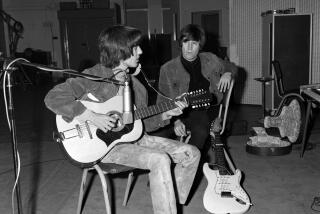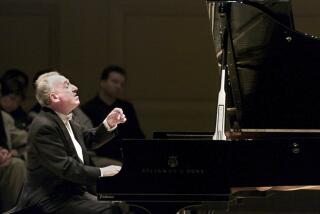‘NAGYVARIUS’--A VIOLIN MADE IN THE MASTER’S MOLD
Stradivarius. That name, like Rolls-Royce, has become synonymous with perfection in craftsmanship. The 600 or so surviving violins, violas and cellos that emerged from the shop of Antonio Stradivari more than 200 years ago have become irreplaceable to the musicians and collectors who possess them.
And they have remained enigmatic to the generations of experts who have attempted to unlock the secret of just what makes a Strad sound like . . . a Strad. Until now.
A Texas A&M; biochemist who’s “always been attracted to the sound of the violin” thinks he’s finally figured it out. Joseph Nagyvary believes that the master instrument maker of Cremona and his benchmates received assistance from an unexpected helper: Mother Nature. And in an unlikely form: Mold--green, slimy mold.
In Nagyvary’s view, Stradivari evidently got his wood dry by first getting it wet, wet enough for fungi and bacteria to enter and make their personal contribution to great music.
What’s so special about the slime? The Hungarian-born researcher provides a brief, simple lesson in biochemistry:
If allowed to thrive, the fungi and bacteria will release enzymes that chew up the natural glue holding water within the wood. That glue, known as hemicellulose, normally binds up the cells. With a loss of only 50% of the hemicellulose, the cells begin to break down, allowing water to be released. The resulting wood is lighter and drier, qualities that contribute greatly to a warmer tone.
This revelation, made after years of analysis of microscopic samples provided by Library of Congress instrument restorer Rene Morel, “contradicts the type of seasoning used everywhere for the last 150 years,” Nagyvary notes during a conversation from his home in College Station.
Craftsmen such as those of the German-based Mittenwald School “have always gone straight to the mountains for their wood,” he points out. “They cut down the trees, carry them overland and dry them for long periods in sheds. Under those conditions, fungi and bacteria can’t grow and degrade the wood properly. So the water can never really escape.” The resulting sound is “harsh, piercing and not pleasant.”
By contrast, the lumber used by Stradivari spent much of its early life immersed in liquid--home sweet home for fungi. “The cut logs were transported along waterways till they reached the cities,” Nagyvary theorizes. “Then they were cured in several solutions.”
The biochemist offers a startling claim: “In only six months, following techniques developed by the Northern Italian masters, I can get spruce drier than similar wood that has sat in a shed for 200 years.”
What’s more, he says he has proof.
Using a team of European craftsmen and his own skills privately honed over the years, Nagyvary has put his theories into practice, producing nearly two dozen violins patterned in exacting detail after the masterpieces of Stradivari. How do they sound? Nagyvary doesn’t hesitate in his reply.
“These violins sound as good as instruments in the $200,000 range.” A top-quality Stradivarius, such as the legendary “Allard,” has sold for more than $1 million. The asking price for a Nagyvarius: $6,000.
What is the reaction of an expert with less personal involvement than the Texas biochemist?
Robert Cauer, a North Hollywood violin maker and dealer (and a graduate of the Mittenwald School) knows of Nagyvary’s work, but has never met him, nor has he heard a “Nagyvarius.” He does, however, remain skeptical.
“It’s usually the non-professionals who claim that they have found the answer (to the Stradivarius mystery),” he says. “Every decade or so there are people who do experiments. Sometimes they get in the paper. Then they disappear, their promises unfulfilled.”
Charles Rudig, vice president of the musical instruments division at Sotheby’s auction house in New York voiced similar doubts. “Frankly, I don’t even think there’s such a thing as ‘the secret of the Stradivarius.’ I’ve heard some of Dr. Nagyvary’s instruments and to me they sound like nothing-special violins. But I don’t want to belittle his work. He seems to have come up with some interesting ideas.”
Those words were echoed by Cauer: “I believe one should experiment. We can only profit by Nagyvary’s knowledge and expertise. But his work must be judged years afterwards.”
Cauer insists that the key to a fine violin is “the arching (the curve of the body), the thickness and quality of the wood.”
No argument there from Nagyvary. “All those elements are important,” he agrees, “but they can all be derived so simply with computer analysis.
“It amazes me that violin makers don’t use all the tools at their disposal,” the biochemist says. He was able to create Stradivarius sound spectrums by simply charting recordings made by such celebrated Strad owners as Isaac Stern and Nathan Milstein.
“Here we are in the ‘80s,” he adds, “yet few of (the violin makers) know about spectrum analyzers. And none of them have even heard of hemicellulose.”
How about Stradivari? Was he aware of the presence of that slippery green stuff, and what it was accomplishing? Yes and no, Nagyvary theorizes.
“While I doubt that he knew just what the bacteria and fungi were doing, he and other craftsmen had certainly observed the mold--it’s quite visible. And they knew the advantages of soaking. They knew that some solutions prevented wood from cracking.
“Violin makers have been known to dip wood in all sorts of crazy solutions. I know of a Swiss fellow who’d use the liquid he collected from underneath horse dung.”
While the solution itself is important (he has developed a five-step process), Nagyvary stresses that the crucial factor in soaking is not what but when . “Violin makers use material acquired from a commercial dealer--and all that wood is already dry-seasoned. In that case, soaking will be to no avail. You must use green, freshly cut wood, otherwise the bacteria cannot penetrate. Stradivari’s spruce was cut in the cold of winter and then sent downstream with the spring floods.
“Do you know why there haven’t been any good violins made in Italy for a hundred years? In the 1840s, they dammed up the rivers.”
If, as things appear, Nagyvary has made a breakthrough, why then is the music world not beating a path to his door?
Such noted violinists as Charles Treger, Itzhak Perlman and Isaac Stern have briefly sampled a Nagyvarius on visits to San Antonio but, says the violin maker, have declined to offer an endorsement: “There was not enough time for them to get a sense of the instrument--and besides, professional endorsements are big business and not to be treated lightly.” Yehudi Menuhin was interested enough in Nagyvary’s work to obtain a violin on loan recently. Reached in London last week, Menuhin confessed, “I can’t give an opinion, unfortunately, since I haven’t had time to work on it.”
In general, other instrument makers, Nagyvary notes sadly, “dismiss my work by saying things like, ‘A violin made by a chemist? It will self-destruct in no time.’ ”
According to Nagyvary, the attitude working most strongly against him--among famous musicians and collectors--is that a violin is a piece of fine art. “Everyone talks about the age of an instrument and about the craftsman who made it. They criticize my violins because they are built by a team. But look at a violin by Amati (Stradivari’s teacher). When an instrument was finished, he didn’t sign it--he used a stamp. He didn’t view it as a work of art.”
Violin-maker Cauer agrees: “Watch (a potential buyer) studying a violin. The first thing they look at is the label. A dealer doesn’t determine the price--it’s whatever we can get for an instrument. If a cheap instrument happens to sound good, the buyer won’t bite. For them, you can put a Rolls engine in a VW, but it’s still a VW.
“Personally,” he adds, “I’ve heard some $100,000 instruments that sounded horrible.”
Dealers and violin makers may snub him, but young violinists--at least those who’ve had firsthand experience with a Nagyvarius--have unhesitatingly come to his defense. A recent convert is British musician (now New Orleans-based) Catherine Lord, who recently played on three borrowed instruments at one of the biochemist’s frequent lecture-demonstrations--this one at Texas A&M.;
Following an introduction by the violin maker himself, Lord played briefly on her own Matteo Gofriller (Venice, 1705) and on the three by Nagyvary, then gave a full recital on one of the latter. The following day, Lord spoke highly of her encounter with the Nagyvarius that she chose for the recital.
“Actually, I was quite knocked out by it,” she commented. “Other recently made violins I’ve played have that big sound, but not the singing quality of this one.” Such praise is the more remarkable since the instrument in question was completed only 10 days previous.
“There are those who say that a violin must age before it can be properly handled, but obviously those people are wrong,” she said. Of the brand-new instrument, she remarked: “It gave me back what I gave it. The violin has a life of its own.”
Afterward, some audience members told her “they heard the violin actually get better during the concert.”
Yung-hwi Tuan is a Galveston-based musician who owns four “really good” violins (most in the $10,000 range). But the best, he claims, is the $6,000 instrument he bought from Nagyvary last year. “The tone is very pure and even. If you listen without knowing, you’d say, ‘This is a good Italian violin.’
“There’s so much logic in the making of this instrument, it makes you wonder why they (other makers) didn’t think of these methods earlier. I realize there are a lot of skeptics among them. But you have to understand that the (violin-making) business can be very ugly.”
Lord seconded those sentiments: “Dealers and makers are a clique unto themselves. They are all very guarded and jealous. Some may regard (Nagyvary’s) work as a threat.”
Will the Nagyvarius ever gain acceptance? The instrument’s creator remains unconcerned. “All I want is the approval of young players. They can help spread the word at competitions.
“I’m 52 now, nearing retirement. But I figure I have 30 years of violin-making ahead of me. Stradivari died at 94.”
Meanwhile, his European crew will continue producing the tops and backs, with Nagyvary doing the final sanding (with hunks of broken glass), the gluing and the crucial--and arduous--varnishing.
The scientist/violin maker turns momentarily philosophical: “George Szell once said, ‘Violin playing is so difficult. Every violinist deserves a Stradivarius.’
“In a few years, this may become a possibility.”
More to Read
The biggest entertainment stories
Get our big stories about Hollywood, film, television, music, arts, culture and more right in your inbox as soon as they publish.
You may occasionally receive promotional content from the Los Angeles Times.










